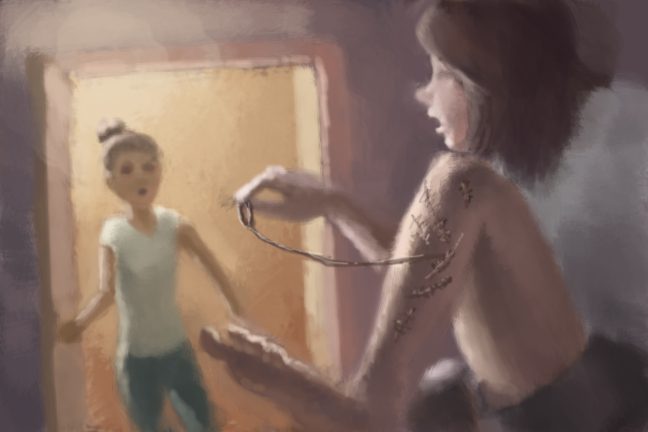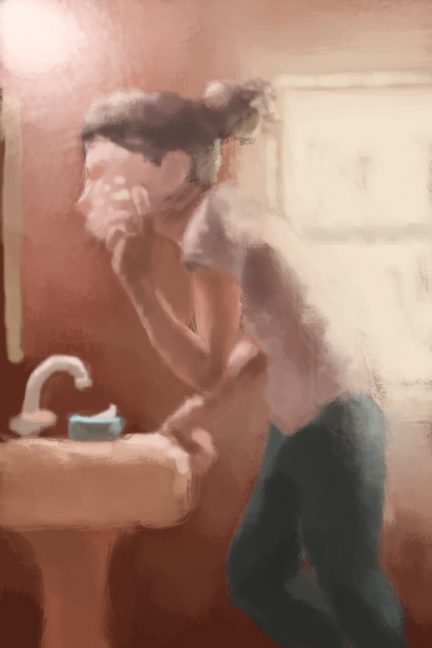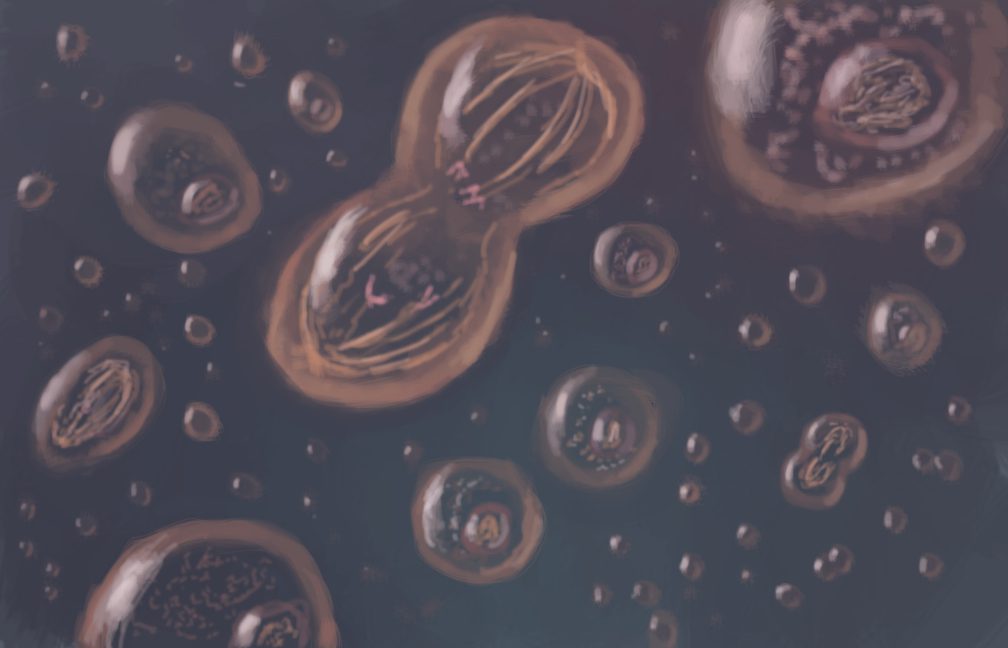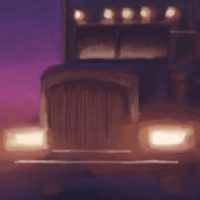My sister’s leg is a patchwork of scars. They run like veins down her right thigh to her calves. My sister’s leg is missing a kneecap. It dimples in, the web of scars reaching out. When I see her, I look for her scars. I stare at them. My sister’s scars are beautiful.
Cathy was in a car accident. She and my other sister Becky were driving from Florida to visit me in Iowa. Cathy tried to pass a semi on a two-lane country road. She hit an SUV head-on. They were in a much smaller car, a Honda CRV. I saw the wreckage the night of the accident. My husband and I drove to Missouri to be with my sisters in the hospital. But as we arrived, they were being airlifted to Iowa, to a hospital near where I lived.
I only got to squeeze Becky’s hand before she was wheeled away. Cathy was already in the air. She was hurt worse and needed emergency surgery. No one said the word “die” or “death,” but it was the subtext of what I was told. She was “critical.” She needed more help than the hospital in Missouri could provide. I wouldn’t be able to see her, anyway. She would probably be in surgery for hours. So a nurse, or a doctor, or someone—maybe a policeman—suggested we go to the scene of the accident and see if we could salvage any belongings. In hindsight, it was a kind suggestion. It gave me a practical outlet for my grief, for my fear.
At 9 o’clock on a Friday night, I found myself in the parking lot of an auto repair shop outside Hannibal, Missouri, crawling through the wreckage of an electric blue Honda CRV. Crushed grapes made my hands sticky. Becky had been bringing gifts back from France. The car was covered in a dusting of coffee grounds and everything reeked of moldering cheese. My husband and I had first stopped at a gas station for supplies, and together we scooped books, clothes, and shoes into black trash bags. Despite the fear, love, and worry that clogged my throat as I worked, I was still irritated when I discovered my clothes among Becky’s belongings. She’d stolen my college sweatshirt and my favorite scarf, which was now buried under Stratego pieces and glass.
Who travels with Stratego? Why was there rice on the ground? Was Becky’s cheese supposed to smell like that? These questions were easier to think about than what was facing us back in Iowa.
Would Cathy walk again? Could Becky feel her limbs? Cathy had been given the wrong blood during emergency surgery. So there were more questions, too. Should doctors give her a transfusion and risk additional bleeding in her brain? Or leave it and risk the chance that she would never have children again?
Becky sprained her back and recovered quickly enough to go to a wedding within three weeks, albeit in a neck brace. Cathy stayed at our house for three months, learning to walk again. I drove her to physical therapy and did my best not to ask annoying questions when I picked her up, her face red with pain and exhaustion. When she cried about feeling useless, I put Swiffer pads on the bottom of her walker so she could clean the wood floor. I let her make me bad soup and good sandwiches and wear my clothes, because so many of hers were covered in blood. We fought over which movies to watch (she never wanted to watch Short Circuit or The Firm. I thought Band of Brothers was ridiculous). We fought over whether it could snow at 40 degrees Fahrenheit.
One night, I knocked on the bathroom door. I needed to pee.
“Don’t come in,” Cathy said.
“I’m coming in anyway,” I warned her. “You have one minute to get off the toilet.” We only had one working bathroom, and I was desperate. Busting into the bathroom is an indignity sisters are allowed to inflict on one another.
I opened the door. She was sitting on the toilet, fully clothed, her leg out of its brace and propped up on the bathtub. She rolled her eyes at me and went back to picking at the stitches with tweezers. “I need more than a minute to get off the toilet, I’m a cripple.”
I watched her, revolted and fascinated at the small holes left behind in the seams of her skin.
 “This is so ugly,” she said. “I need vitamin E to make the scars go away.”
“This is so ugly,” she said. “I need vitamin E to make the scars go away.”
The scars were so angry and raw. How could they ever go away?
“They won’t always look like this,” I said gently, unable to tear my eyes away from her self-surgery. “It won’t always be so bad.”
“What do you know?” She snapped.
She was right. I didn’t know anything. I was just a sister. So, I went to Walgreens and got vitamin E oil, then used the bathroom at a gas station where I bought three big candy bars. I gave Cathy two and ate one, sitting in her room, trying not to talk about the fact that she’d just unraveled her wounds.
Two years later, I had a newborn and nipples that were raw and bleeding. I found my sister’s vitamin E oil in my cabinet. I used it, hoping for a respite from the pain. The stitches in my perineum throbbed. I thought of my sister pulling her own stitches out and I held my baby, a little girl, and cried.
*
I am 32 and the mother of a four-year-old and a one-year-old. I’m done nursing and in response to that ubiquitous female problem of “hormones,” my skin has broken out. My doctor tells me it’s just my body readjusting. But I feel like a recalcitrant teenager. I research cures on the Internet. I order new lotions and a concealer that costs more than my jeans.
Every night, after I brush my teeth and before I collapse into bed, I stare at my face in the mirror, willing myself not to pick, not to prod or to squeeze. I make rules. Only scrape dry skin with a washcloth. Only touch your throbbing pimples with the pads of your fingers and only once in the morning and once at night. If I have rules, I am less likely to pick. And if I do pick, I will scar.
I think again of the vitamin E oil and I go to Walgreens to get some. I don’t buy a candy bar. I’m watching my weight. It occurs to me that I am no longer fun.
I’m compulsive about purification. I feel demons under my skin and I want to exorcise them. What is it that throbs with pain? What is it that changes? What will I see beneath the pooling blood? It’s a curiosity and a casting out. I used to love getting splinters or chiggers because those are supposed to be dug out. And there was no shortage of them in my childhood, where I spent most of my time playing in the creek behind our house.
What will I see beneath the pooling blood? It’s a curiosity and a casting out. I used to love getting splinters or chiggers because those are supposed to be dug out. And there was no shortage of them in my childhood, where I spent most of my time playing in the creek behind our house.
As a child, I picked at night, lying beneath my covers reading a book. I picked at the table, listening to my parents fight. I picked during church while contemplating my eternal fate. I picked when I lay awake at night, praying to Jesus that the apocalypse wouldn’t come before I had time to find love. I picked when I heard my dad coming home late, again.
Now I am an adult and I have rules—ways to control my compulsions. I write these rules down on a piece of paper. But at night, I stare in the bathroom mirror and I contemplate the wounds on my face. Are they battle scars? Am I self-harming? Self-purifying? Is it stress or compulsion? Part of me doesn’t care. I just want them gone. I spend a lot of money trying to get back to the way it used to be, the way I used to feel, with perfect skin.
It feels indulgent to compare my vanity to my sister’s debilitating injuries. And yet, this connection between what is on our skin and what lies beneath becomes so evident every time I look in the mirror. My vagina was ripped, third-degree tears, both deliveries, both times. No scars. No lingering pain, just an inability to sneeze without leaking pee. And now, my face. This was a choice. Unlike my sister’s accident. Or was it? Why did my sister try to pass that truck on the one-lane highway, a maneuver she’d never tried before? Do we, as Milan Kundera wrote in The Unbearable Lightness of Being, organize our lives according to the laws of beauty or the compulsions of our pain?
Even before her legs were crushed, my sister had internal pain. Three years before the accident, my sister told us she had been the victim of molestation. At first, no one believed her. Even now, years later, she still has to fight to make people remember. My family encourages forgiveness and healing, which means, when we draw names for gift giving or talk about a family gathering, we never speak about my sister’s confession. When we watch movies where girls are hurt (isn’t that every movie?) we say nothing at all.
What was in her that gave rise to recklessness at the wheel? Or did the wounds only become connected afterward in my mind? This is what I think when I contemplate my face too long in the mirror. It’s self-involved, but it’s also sister-involved. I want to go back to when I was unblemished. To when she was unwounded.
But it occurs to me that I’m misremembering. Maybe there never was a time when we didn’t have something red and angry erupting from deep inside us.
*
Interphase. Prophase. Prometaphase. Metaphase. Anaphase. Telophase. Interphase-Prophase. Transition. The stages of cell division. This is how skin heals. Beneath the scab, skin cells divide, multiplying and replicating over and over, starting at the edges and moving to the deep center.
Immediately after a wound is sustained, your body begins to heal. Blood vessels around the wound restrict blood flow. Platelets coagulate in the wound. Clotting proteins in the blood help create the scab, the protective layer that allows skin to grow and your wound to heal.
If your wound is superficial, there won’t be a scar. But for deep cuts and lesions, your skin creates fibrous scar tissue instead of the smooth, granular tissue of the epidermis. There are different types of scars. Hypertrophic scars are sometimes red and itchy at the site of the wound. Keloid scars are also red and painful, but they take over healthy skin. No one knows why keloid scars happen. No one knows why the normal healing process would turn something unwounded into a wound. No one knows why an old and angry pain keeps spreading outward.
 Blood clots. Cells divide. Healing begins.
Blood clots. Cells divide. Healing begins.
But I still don’t know what it means to heal. Does it mean your skin returns to normal? Does it mean that no one can tell you were cut? That you fell? That you were hit? Does it mean the pain goes away? Or does it only mean that the immediate bleeding stops?
We rarely treasure our scars. Instead, we seek to erase them. There is a whole industry devoted eliminating that fibrous tissue. But me, I wish I had more of it. I wish I had some proof.
In The Book of Laughter and Forgetting, Milan Kundera writes that the struggle of power is the struggle of memory against forgetting. This is why we hold onto our wounds. To erase them means this pain never happened, that it never meant anything. But in exchange, we get the bliss of forgetting.
Wounds heal in a circle, from the outside in. Seeking forgetting in the healing. When we think of wounds, we want them to heal. We want our bodies to forget. We don’t want them to bear witness to the pain. Then again, sometimes we do. Sometimes we want the evidence.
Kundera writes that circles are “cruel.” If someone leaves a circle, hands can rejoin, and then it’s as if they’d never left. He writes: “It is not by chance that the planets move in circles and that a rock coming loose from one of them goes inexorably away, carried off by centrifugal force. Like a meteorite broken off from a planet, I left the circle and have not stopped falling. Some people are granted their death as they are whirling around, and others are smashed at the end of their fall. And these others (I am one of them) always retain a kind of faint yearning for that lost ring dance, because we are all inhabitants of a universe where everything turns in circles.”
I had a miscarriage once. It was so early. I only knew I was pregnant because my body betrayed me, leaking milk while I was on my morning run. I took a test and shared the news with my husband. A week later, I was bleeding so heavily I gave up trying to use pads and just sat on the toilet and cried.
There is no evidence of that pregnancy except the doctor’s note in my chart: three pregnancies, two children. Sometimes I remember, and I cry. I wish I had something more, some evidence that this happened, that someone was there. That a third life existed briefly within me, and that I miss it. I don’t want to be political. I just want to bear witness to my pain.
I don’t want a world in which I forget. But I also do, because it’s easier to breathe when you aren’t constantly carrying your own personal cross.
*
In the Old Testament, Abraham is called to seal his deal with God through blood. The deal is that Abraham and his descendants receive land and the blessing and favor of God in return for following him and doing what he asks, always. To consecrate this promise, Abraham was asked to cut animals in half and lay them on the ground, leaving a small path between the desiccated bodies. Then God put Abraham to sleep. Normally, both parties in the deal would walk between the carcasses, a symbol of the promise that says, “So may this happen to me if I break the deal.” But Abraham is put to sleep, and in his dreams he sees a smoking pot and a flame walk between the dead animals. Both are Mesopotamian images of God. A God sealing his promise with blood. In the tradition of Middle Eastern covenants, the dealmakers were to also cut themselves and then mingle their blood. According to the Bible, this wound, the wound that bound Abraham to God, was circumcision.
I don’t know how God bled. Theologians argue that later, when Jesus died on the cross, this was the other part of the covenant—blood for blood. But if you don’t believe in Jesus, if you are a Jew or an atheist, it seems pretty one-sided: that God required a wound without sustaining one in return.
The wound, like the animal sacrifice, represents a kind of mutually assured destruction—so may this happen to me if I break our bond. But these wounds are choices. Voluntary pains for a higher faith. I once heard a pastor preach a sermon on circumcision, saying, “No one would choose to do this to themselves. It’s a requirement of faith.” He was speaking to a mega church in a wealthy suburb of Minneapolis, a place where girls were cutting themselves, over and over. Choosing to bleed. Choosing to make their pain grow and bloom red on their skin. Even I knew that, sitting in the pew at 18. Why didn’t he? Or did he not believe it? Did he not think that the choice to cut one’s self counted? Did he even believe in the throbbing pain that all those girls were exorcising? Did he think the pain was mythical and not worth addressing? Even now, when I think about that, I want to stand up and yell, “You are why they hurt themselves, because you don’t believe them!”
But really, I’m not mad at the preacher. The truth is, I’m still mad at my family for denying my sister’s pain when she told us about her abuse. We never speak of it, and in that way, the reality of what happened to her becomes muddled in a way that pain never is.
Sometimes, I find myself turning to my husband and asking, “That did happen right? This happened?”
He nods. He remembers holding me as I cried. He’s more sure about things. Perhaps because he’s never had to prove his pain.
In a perverse way, I’m glad my sister has scars. They are her pain made manifest. She can say she is in pain, and point to her scars. She has something she can hold up to people who might try to deny that she has been hurt.
to deny that she has been hurt.
I have pain, too. There are Thanksgivings when I have to sit and listen to talk of my sister’s abuser like he’s not the person who ruined our lives. Times when I’m sent terse emails reminding me not to write about the time our dad left. “Be honest, but only about your life,” they say.
But that time, that experience, is my life. It is me. I want to stand up and scream, THIS HURTS TOO! But what can I point to? What evidence do I have of the demons under my skin?
Once my mother asked, “Why are you so angry? Were you abused by someone, too?”
I was outraged. “These are my sisters. What happens to them happens to me.”
“It’s not about you,” she replied.
But it is.
In a poem titled, “I Wish I Had More Sisters,” Brenda Shaughnessey writes:
My sisters will seem like a bunch
of alternate me’s, all the ways
I could have gone. I could see
how things pan out without
having to do the things myself.
The abortions, the divorces,
the arson, swindles, poison jelly.
But who could say they weren’t
myself, we are so close. I mean,
who can tell the difference?
Later she writes, “Each of us could be all of us.” Because that’s how it is with sisters. You are them. You are not them. You are broken shards from the same pane of glass, each reflecting a different light.
In my mind, I am always hearing my mother say this. “It’s not about you.” Because she is right, and yet so very, very wrong. My sisters’ blood is my blood. Our wounds have been mashed together in some sort of promise that is both divine and perverse. We have a covenant. At one point we all walked through a valley of blood and said to one another, so may this happen to me. Maybe we didn’t even have a choice. Maybe it’s just the curse of coming out of the same womb. Maybe it’s the blessing. But whatever it is, their pain is all about me, even as it has nothing to do with me.
The Bible says that, without the shedding of blood, there can be no forgiveness. Without forgiveness, there is no healing.
But I still don’t know what healing is.
All I know is that my sister still has scars. She is getting tattoos on her legs. Tattoos she’s designed. They are beautiful, but they still don’t cover anything up.
And while I relish her scars, I know she hates them. I know she wishes they would go away. I know she still clings to vials of vitamin E oil, hoping to restore her skin to the way it used to be, perfect and smooth.
But it occurs to me that she might be wrong, too. There might never be a time when she wasn’t wounded, when her body wasn’t cut up. Maybe she’s always been like that. Maybe I have always been like that. It’s hard to remember a time when we weren’t.
***
Rumpus original art by Estevan Guzman.





5 responses
Powerful writing as always. Lyz can touch a nerve I didn’t realize I ever had.
Incredibly powerful. Captivating. Stark. Real. I absolutely loved this. Thank you for sharing.
Thank you so much for this.
Oh my. So beautiful. Thank you for writing and sharing.
The ways you are able to wrangle impossible issues like hurt and pain with such narrative ease is both intense and necessary. Thank you.
Click here to subscribe today and leave your comment.